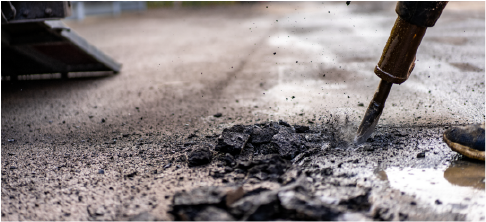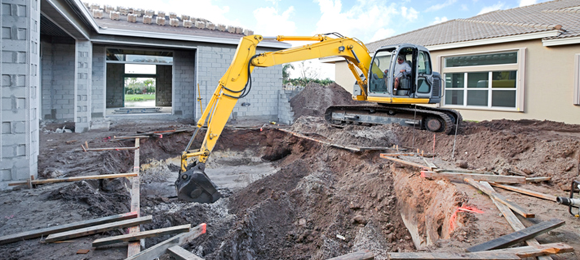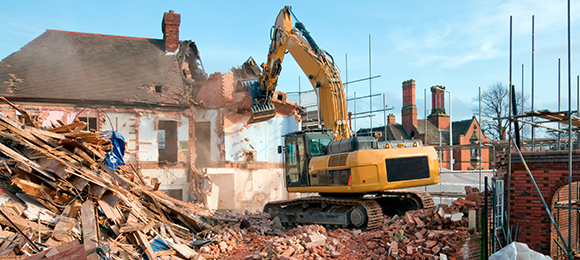
Updated January 23, 2023
If your home was built in the 1980s or earlier, there's a good chance your home contains some type of hazardous material, the most common types being asbestos and lead.
If left undisturbed, these typically do not cause any health issues.
However, once these hazardous materials become compromised or are disturbed somehow (e.g. chipped paint or interior demolition), they become dangerous.
This is why it's key to manage and safely remove all hazardous materials before beginning a demolition or remodeling project.
Below, find out how to manage lead-based paint and asbestos debris to ensure you keep yourself, your family, and the environment safe.
How to Manage Lead-Based Paint Debris

Banned in the late 70s, lead-based paint is common in structures built up until that point.
Lead paint is most commonly found in walls, windows, doors, and siding.
The mere presence of lead paint does not automatically pose a health risk.
If cutting, scraping, or sanding this paint, or if the paint is peeling, lead exposure and contamination become a concern.
Not only can workers and homeowners become exposed to the dust and debris, but the soil and surface waters can also become contaminated.
Lead poisoning is a serious health risk for children and adults, causing anemia, reproductive disorders, and damage to the brain, liver, and kidney.
Hire a Contractor
If you're performing a renovation or remodel, or you simply want the lead-based paint in your home or business abated, contractors licensed to do so are allowed to dispose of such paint waste with the regular household garbage.
It's not required for them to determine whether the waste meets the toxicity characteristic under the Resource Conservation and Recovery Act (RCRA), but they should contact your state and local agencies for additional requirements.
Common Lead-Based Paint-Containing Debris:
- Window frames
- Doors
- Painted woodwork
- Paint chips/dust
Though these items may technically be considered household hazardous waste (HHW), you should take several precautions to protect your health and the environment.

Safety Steps to Follow When Disposing of Lead-Based Paint
Step 1: Manage the Small Stuff
Contain and collect small bits of lead-based paint-containing debris, like dust, dirt, and paint chips, in plastic trash bags for disposal.
Use a vacuum with a HEPA filter to be sure you trap all particles.
Step 2: Use a Dumpster for Larger Debris
Place larger debris containing lead-based paint in containers, like trash bins or covered dumpsters, until the job is completed and it's time for disposal.
Find a local dumpster provider near you.
Step 3: Follow Local Laws
Contact your local solid waste agency to determine exactly where and how to dispose of lead-based paint debris.
Step 4: Practice Safe Hygiene
Always wash your hands and face before eating, drinking, or smoking, and do not do so around lead-based paint work.
Do not wear clothes that are covered in lead-based paint dust into your home.
How to Manage Asbestos Debris
Asbestos-containing materials (ACMs) were commonly used for insulation and fire resistance purposes in the construction industry from the late 1930s to the 1980s.
So if your home or business was built during this period, it's likely the structure contains asbestos somewhere.
Common Asbestos-Containing Materials:
- Insulation (blown, rolled, and wrapped)
- Asbestos siding shingles
- Asbestos cement products
- Asphalt roofing products
- Resilient floor covering (tiles)
Because it can cause a range of health complications, like lung tissue scarring and cancer, asbestos is strictly regulated by the EPA and OSHA.
Hire a Contractor
There are a number of regulations to abide by when removing asbestos and, as such, should always be handled by a professional.
Under the Asbestos National Emissions Standards for Hazardous Air Pollutants (NESHAP), some types of ACMs are subject to special disposal requirements, while others are not.
The Asbestos NESHAP has a zero visible air emissions standard for asbestos removal and requires contractors to follow specific work practices when working with ACMs to ensure adherance to these standards.
Regardless of whether asbestos is present at a demolition or renovation site, NESHAP regulations require contractors to submit a written notice to the state or local pollution control agency or to the EPA Regional Office 10 working days prior to the start of construction activities.
Some EPA Regions require that both EPA and the state or local office be notified. Additionally, the building site must be inspected by a certified asbestos inspector, and owners and operators must have samples of materials suspected of containing ACM collected and tested prior to the start of construction activities.
In addition to NESHAP regulations, some states also have additional asbestos requirements which should also be considered during demolition and renovation projects.
NESHAP categorizes ACMs into three distinct types, and each type has different disposal requirements.
Hiring a licensed professional to handle your asbestos abatement is key to your safety and the project's overall success.

3 Types of Asbestos-Containing Materials
Friable ACMs
Including sprayed-on fireproofing and insulation, these types of ACMs are considered 'friable' because they can be easily crumbled with hand pressure.
These ACMs are always regulated under NESHAP when disturbing during demolition or renovation.
Category 1 Non-Friable ACMs
Including floor tiles, these ACMs are not easily crumbled and are not considered a regulated material.
These ACMs don't require removal prior to demolition or renovation unless subjected to sanding, cutting, grinding, or are in poor condition and friable (easily crumbled).
At this point, they are considered a regulated material and must be removed accordingly.
Category 2 Non-Friable ACMs
Including asbestos cement, this type of ACM should be assessed on a case-by-case basis.
If likely to be crushed in some way during demolition or renovation, these materials should be treated as a regulated ACM and removed before starting the project.
Any time regulated ACMs are present at a work site, whether for a demolition or remodeling project, they must be wrapped properly or packaged in airtight containers and disposed of at a licensed disposal site near you.
Non-regulated ACMs can be disposed of in landfills that accept ordinary demolition waste.
You can get a list of approved disposal sites from your state and local agencies responsible for asbestos removal regulation, or check their website.
Find a qualified interior demolition contractor to help with your project
Keep reading:


